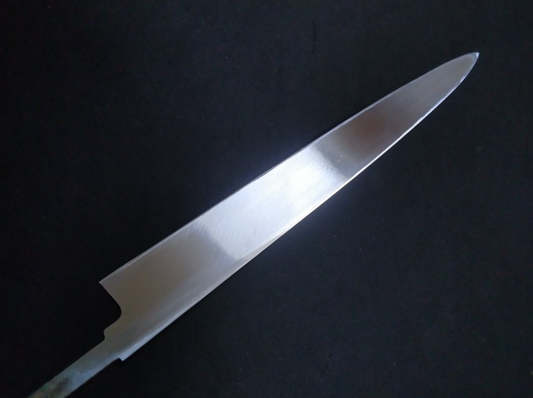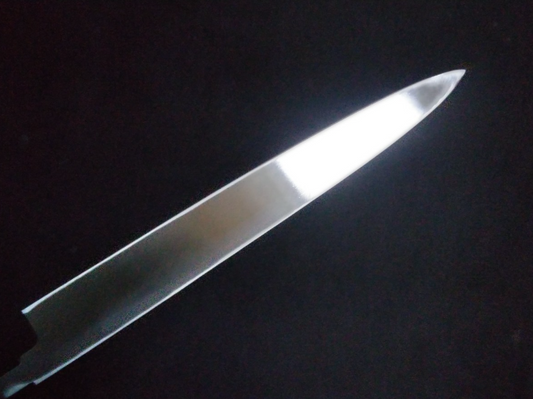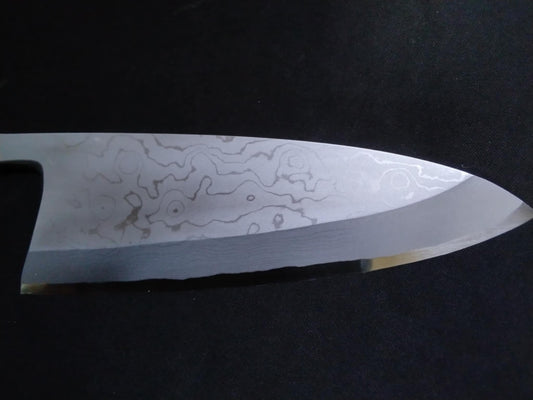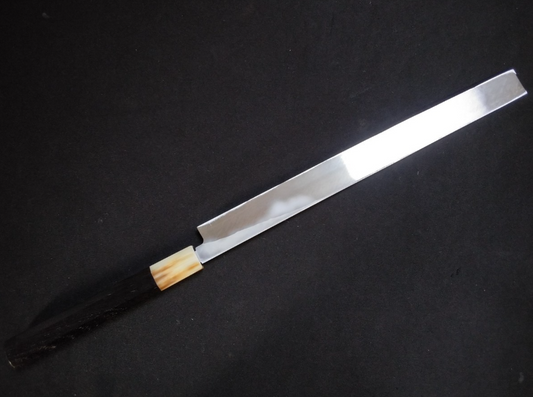
-
All Japanese Knives from Sakai City
-
— Do you know who made the knife you're about to purchase?
Does the store staff know which craftsman created the knife you’re considering? -

At KIREAJI, we ship knives directly from the Shiroyama Knife Workshop in Sakai City, Osaka, to customers around the world. By operating a direct-to-customer model without middlemen, we have a precise understanding of who crafted each knife. This allows us to confidently deliver handcrafted masterpieces with a clear lineage to our customers worldwide.
-

Meticulously Handcrafted
For the sake of sharpness, the hammer is wielded before a 1100-degree flame.
Why Is Sakai City Famous for Knives?
-
Discovering the Hidden Legacy Behind Japan’s Cutlery Capital
When people think of world-class knives, they often imagine German or French brands. But in Japan, there's one small city that has quietly earned a global reputation among chefs and knife collectors alike: Sakai City, located just south of Osaka.
So what makes this unassuming city the heart of Japanese knife-making?
-
A Legacy Forged in History
From ancient iron tools to modern kitchen masterpieces
Sakai's knife-making roots date back over 1,600 years, beginning in the Kofun period, when iron tools were first produced for building massive burial mounds. Over centuries, these blacksmithing skills evolved—and during the Edo period (1603–1868), Sakai became nationally renowned for crafting specialized knives to cut tobacco leaves. These so-called “tobacco knives” required extraordinary precision and durability, setting a new standard for quality.
This was the birth of Sakai Uchihamono—Sakai-forged blades—and it marked the beginning of the city’s reputation as a top-tier cutlery producer.
-

Samurai Roots: The Influence of Swordsmiths
The spirit of the katana lives on in today’s kitchen knives
Sakai’s knife-making tradition is deeply connected to Japan’s samurai sword culture. After the decline of the samurai era, many swordsmiths redirected their craft from making katanas to producing high-quality kitchen knives.
Their meticulous forging techniques—such as folding steel for strength and conducting precise heat treatments—were passed down through generations. This heritage of craftsmanship remains the backbone of Sakai’s knife industry today.
-
A Culture of Generational Craftsmanship
Mastery passed down through families, not factories
Unlike mass-produced knives from large factories, Sakai’s blades are created by specialized artisans, often in small family-run workshops. Many craftsmen are part of a system where each knife passes through separate experts: one for forging, another for sharpening, and another for attaching the handle.
These skills are passed down over generations, often from parent to child, preserving not just the technique but also the pride and philosophy behind each blade. This is what gives Sakai knives their soul—a rare blend of history, human touch, and relentless pursuit of perfection.
-
-
All Japanese Knives from Sakai City Collection
All knives come with a complimentary Saya(Sheath).
-
White Steel #2 KoDeba(Small Deba) 90mm-Mirror Polished(one side)
Regular price $220.00 CADRegular priceUnit price / per$0.00 CADSale price $220.00 CAD -

 Sold out
Sold outWhite Steel #2 Yanagiba 210mm
Regular price $260.00 CADRegular priceUnit price / per$0.00 CADSale price $260.00 CADSold out -
White Steel #2 Yanagiba 240mm-Kido Finishing
Regular price $260.00 CADRegular priceUnit price / per -
Blue Steel #2 Yanagiba 240mm-Mirror Polished(one side)
Regular price $279.00 CADRegular priceUnit price / per$0.00 CADSale price $279.00 CAD -
Blue Steel #2 Yanagiba 270mm-Mirror Polished(one side)
Regular price $298.00 CADRegular priceUnit price / per$0.00 CADSale price $298.00 CADSold out -
White Steel #2 Yanagiba 270mm-Kido Finishing
Regular price $300.00 CADRegular priceUnit price / per -
Blue Steel #2 Deba 170mm- Kido Finishing
Regular price $320.00 CADRegular priceUnit price / per$0.00 CADSale price $320.00 CADSold out -

 Sold out
Sold outWhite Steel #2 Usuba 210mm
Regular price $346.00 CADRegular priceUnit price / per$334.00 CADSale price $346.00 CADSold out -
White Steel #2 Damascus Deba 150mm-Mirror Polished Blur Finish
Regular price $346.00 CADRegular priceUnit price / per$0.00 CADSale price $346.00 CADSold out -
White Steel #2 Takohiki 270mm-Kido Finishing
Regular price $350.00 CADRegular priceUnit price / per -
Blue Steel #2 Yanagiba 270mm- Kido Finishing
Regular price $365.00 CADRegular priceUnit price / per$0.00 CADSale price $365.00 CADSold out -

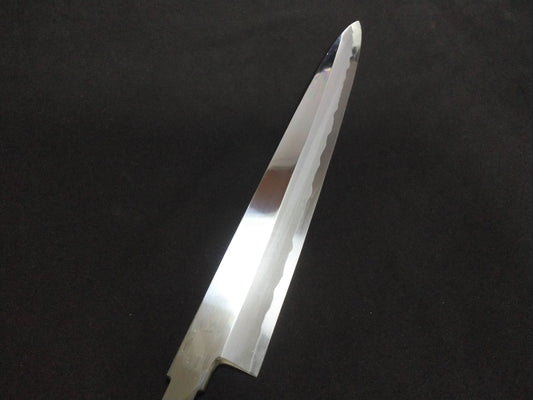 Sold out
Sold outWhite Steel #2 Yanagiba 330mm
Regular price $380.00 CADRegular priceUnit price / per$380.00 CADSale price $380.00 CADSold out
KIREAJI's Three Promises to You
-

1. Exceptional Japanese Knives
Our knives, crafted by Sakai City's master artisans, combine traditional techniques with carefully selected materials, delivering unrivaled sharpness and durability.
-

2. For a Lifetime of Use
At KIREAJI, we see knives as lifelong companions. Each knife comes with a free saya, and we offer Honbazuke hand-sharpening by Shiroyama Knife Workshop in Sakai City.
-

3. Supporting the Joy of Continued Use
KIREAJI knives are made to grow with you. That’s why we provide trusted after-sales care (fee-based) .
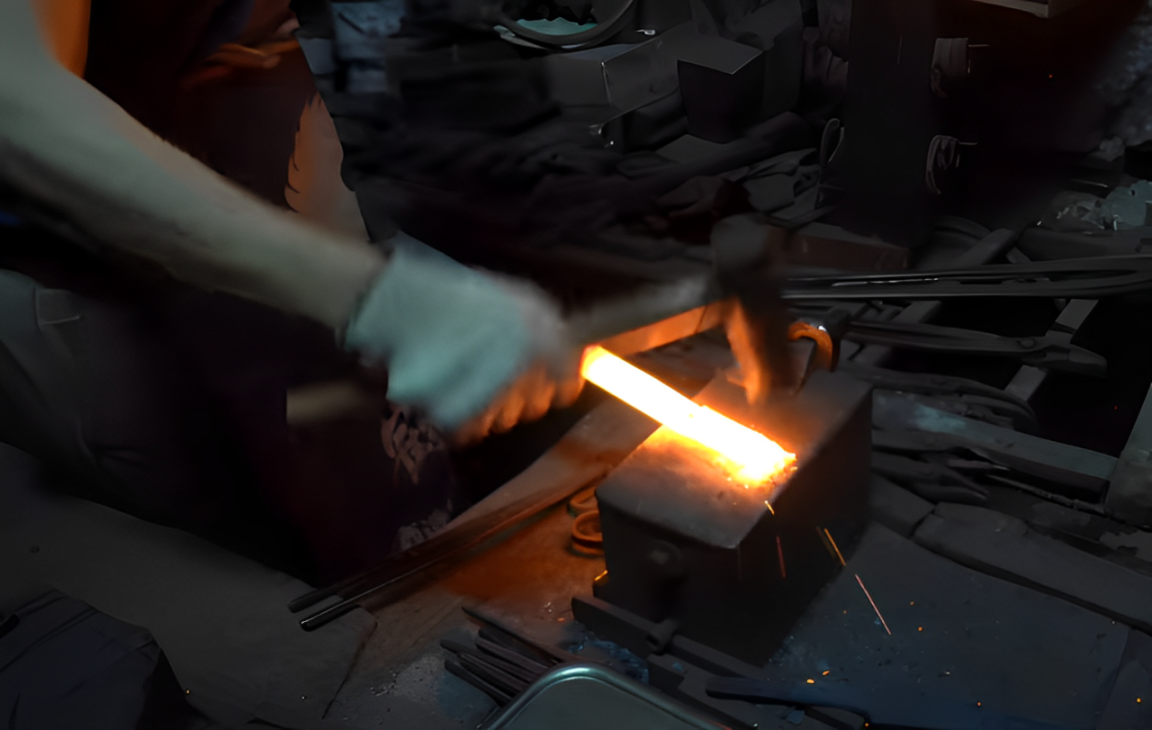
The Artisan's Commitment to Continuous Challenge
Every day is a challenge, but I continue with the desire to pass this craft to the next generation. Creating knives that bring joy to others is my pride, and I never give up.
Why Do 98% of Professional Chefs Choose Sakai Knives?
-
Osaka’s Sakai City produces 98% of the traditional Japanese knives used by professional chefs. These knives are so exceptional that they have been designated as Traditional Craft Products by the Japanese government. Their outstanding quality is supported by two key factors:
-

-
-
Reason 1: Specialized Division of Labor
Sakai’s knife-making tradition is built on a unique system where each step is handled by specialized craftsmen.
-
- Forging: Skilled blacksmiths heat and shape the steel, ensuring superior sharpness and durability.
- Blade Sharpening: Expert sharpeners refine the edge to achieve a razor-sharp finish.
- Handle Attachment: Handle specialists craft and attach handles that feel like a natural extension of the chef’s hand.
-
This system of specialized division of labor allows each craftsman to master their respective skill, producing knives of unparalleled precision and quality. Furthermore, because each artisan is responsible for their specific stage, a healthy sense of mutual tension arises, ensuring that no one can do a half-hearted job. This ultimately results in the creation of higher-quality Japanese knives. Compared to a single artisan handling all steps, this system yields far superior craftsmanship.
-
Reason 2: Handcrafted Manufacturing
While many modern knife-producing regions rely on mechanization, Sakai continues to uphold the tradition of handcraftsmanship.
-

- Every step is meticulously performed by skilled artisans, ensuring exceptional quality control.
- The handmade process allows for perfect balance and exquisite finishing.
- Traditional techniques are passed down, enabling precise adjustments based on years of experience.
-
This dedication to craftsmanship is why Sakai knives are trusted by top-tier restaurants and professional chefs worldwide.
-
The extraordinary quality of Sakai knives stems from their specialized division of labor and meticulous handcrafting. These factors make them the preferred choice of culinary professionals around the globe.
The Three Major Knife-Making Regions in Japan and Their Characteristics
-

Sakai City (Osaka Prefecture)
With a history spanning over 600 years, Sakai is a major center for traditional Japanese knives. It is especially known for professional knives specialized for Japanese cuisine, such as sashimi and deba knives. Sakai knives are highly regarded by many professional chefs in Japan for their sharpness and suitability for the delicate techniques of Japanese cooking.
-
Sanjo (Niigata Prefecture)
Sanjo blends traditional craftsmanship with modern manufacturing techniques. It offers a variety of high-quality Western-style knives known for durability and easy maintenance.
-
Seki City (Gifu Prefecture)
Seki produces a wide range of knives and is particularly strong in Western-style knives. Its knives are known for their ease of use and versatility, serving both household and professional needs.

Sakai's Expensive Knives Enhance Their Value in the Overseas Market for Several Reasons
Sakai's expensive knives hold significant value in the overseas market for several reasons. Celebrated for their masterful craftsmanship, these knives represent a blend of tradition, quality, and cultural heritage, making them a coveted choice among culinary professionals and enthusiasts.
FAQ About Sakai City Knives

What makes Sakai forged knives special?
Sakai forged knives are celebrated for their over 600 years of tradition and unparalleled craftsmanship. Rooted in Sakai City, a region historically renowned for its blacksmithing, these knives carry the legacy of skilled artisanship that began in the 5th century with tools for tomb construction and evolved through the production of firearms and tobacco knives in the 16th century. This rich heritage is the foundation of Sakai knives' exceptional quality and distinctiveness.
1. Superior Quality and Outstanding Sharpness
Sakai knives are crafted using a traditional method known as “tanzo” (forging). By hammering and shaping the metal, this technique refines the internal structure, enhancing the blade's strength and durability while delivering extraordinary sharpness. Additionally, the single-bevel edge design of Sakai knives ensures a sharper cut, producing clean and smooth slices that preserve the natural flavors and textures of ingredients.
2. Trusted by Professional Chefs
Sakai forged knives enjoy immense trust and popularity among professional chefs, particularly in Japanese cuisine. Their precision and sharpness make them ideal for delicate tasks such as preparing sashimi and sushi, where the presentation and flavor of the ingredients are paramount. This extensive use by professionals further solidifies Sakai knives as a symbol of excellence.
3. Deep Expertise Through a Division of Labor
The production of Sakai knives is based on a specialized division of labor. Each stage—blacksmithing, sharpening, and handle attachment—is handled by dedicated artisans who master their respective crafts to perfection. This system not only ensures superior quality but also allows each artisan to refine their techniques, contributing to the creation of world-class knives. Wholesale distributors oversee the entire process, guaranteeing consistency and reliability in every product.
4. 600 Years of Tradition and Innovation
With a history spanning centuries, Sakai forged knives represent the perfect balance of tradition and innovation. While preserving time-honored techniques, the industry continues to adapt to modern demands, making these knives both timeless and relevant in today's kitchens.
Sakai forged knives are more than just tools; they are masterpieces of Japanese tradition and craftsmanship. Experiencing their quality firsthand reveals why chefs worldwide are captivated by their performance and artistry.
Why do Sakai forged knives have such good sharpness?
Sakai knives are traditionally made using a "forging" process that combines soft iron (jigane) with steel (hagane) for the blade. This single-bevel design requires far more effort and craftsmanship compared to mass-production methods like pressing and stamping. However, this results in a stronger, more resilient blade that resists chipping and retains its sharpness for a long time.
What makes Sakai forged knives durable?
In Sakai forged knives, the combination of hard steel (hagane) and softer iron (jigane) gives them both strength and flexibility. The blades are heated in a furnace and repeatedly hammered to densify the metal structure, creating knives with exceptional sharpness and durability.
Why do professionals use knives made in Sakai?
The tradition of knife-making in Sakai has long been based on a division of labor, with separate specialists responsible for forging (tanzō), blade sharpening (hatsuke), and handle attachment (etsuke). Each knife is carefully crafted by hand, and their unmatched sharpness and beauty have made them popular among professional chefs worldwide.
What challenges do Sakai forged knives face?
Although Sakai forged knives boast 600 years of tradition, they are currently facing challenges due to a shortage of skilled craftsmen. With an aging workforce and a chronic lack of labor, there is a pressing need to train young artisans to ensure these traditional techniques are passed down to future generations.
What is the market share of Sakai forged knives?
Sakai City is known as one of Japan’s three major knife production areas. Sakai forged knives, made using the traditional division of labor between blacksmiths (fire forging) and sharpeners (blade finishing), are especially renowned. It’s estimated that knives used by professional chefs in Japanese cuisine account for around 90% of the domestic market share.
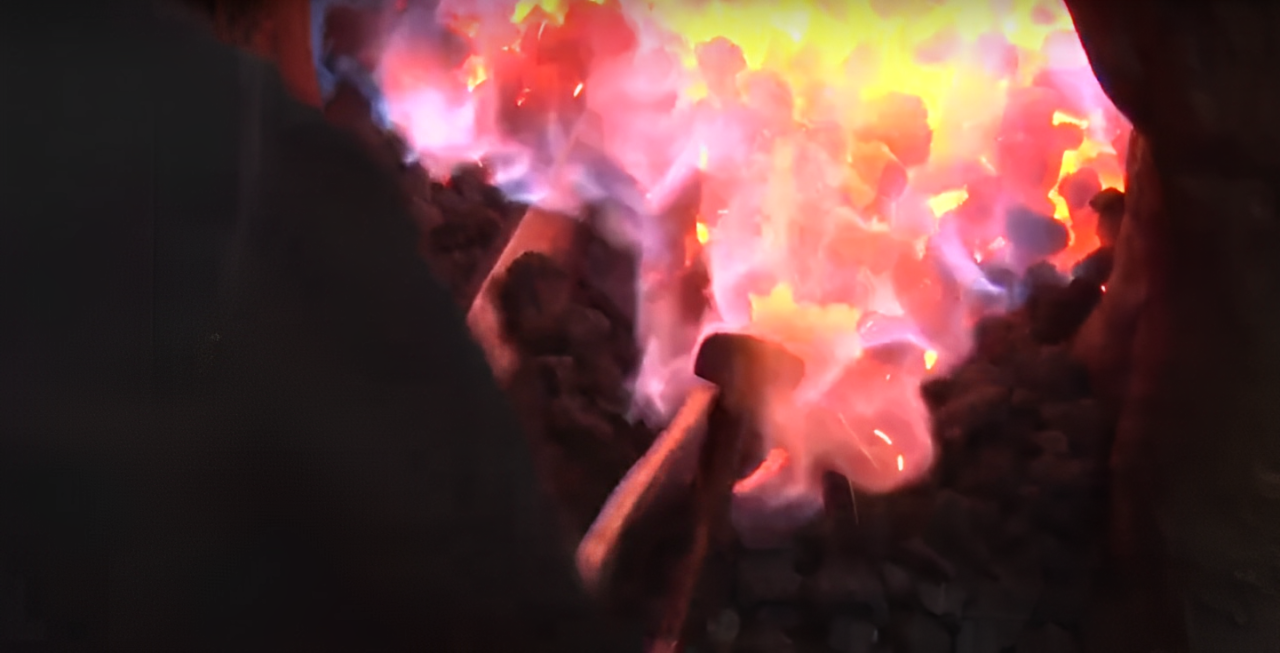
The Story Told by Flame and Steel
Steel speaks through its hues and sparks—soft pinks, vivid purples, and glowing whites. Understanding this silent dialogue requires years of dedication and intuition.Each blade carries the passion of the craftsman and the story of its creation, transforming steel into a timeless piece of art.
The Origin of Craftsmanship
-
The Ultimate Japanese Blade: 600 Years of Tradition
-
The knives we create carry the legacy of 600 years of tradition from Osaka and Sakai. Through countless trials and errors over this long history, the shape of the blade, the properties of the steel, and the techniques of sharpening have reached the ultimate level. For today's chefs, the reason Sakai knives are chosen is not just because they cut, but because of their stability and long-lasting sharpness.
-
Heating the steel, hammering it, cooling it, and sharpening it — each process is done by hand, with the blacksmith pouring their soul into every step. It is this craftsmanship that gives the knife razor-sharpness and durability, making each use a true joy for the chef. By preserving this tradition and embedding it into our knives, we bring 'authenticity' into the hands of chefs. This is the pride of us Sakai blacksmiths.
Video Provided: Japan Traditional Crafts Aoyama Square (YouTube)
-
Beware of Inexpensive Knives
Inexpensive knives are often made with cost-cutting measures during production. Specifically, important elements such as sharpness, balance, and maintainability—key factors that directly affect quality—are not given sufficient investment. These aspects are often difficult to notice at first glance, but they can significantly impact the performance of the knife.
-
At KIREAJI, we offer authentic Japanese knives crafted by trusted artisans from Sakai City. Every knife is carefully handcrafted with a focus on sharpness, balance, and maintainability, ensuring you receive a high-quality product that provides long-lasting reliability and peace of mind.








